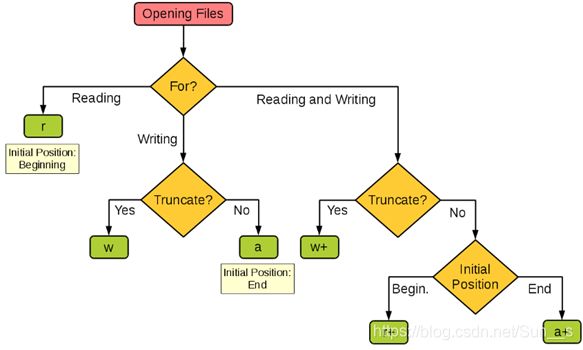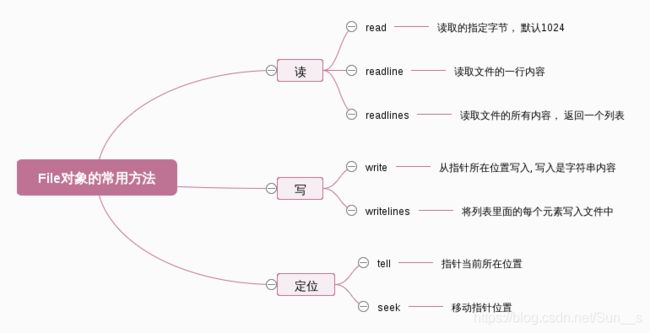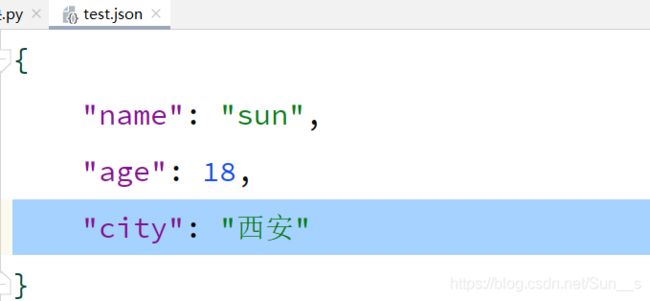python持久化存储文件操作
一、 文件操作介绍
日常中的数据存储在纸上, 而计算机的数据存储在哪里呢? —硬盘上
1. 文件的作用
一个程序在运行过程中用了九牛二虎之力终于计算出了结果,试想一下如果不把这些数据存放起来,相比重启电脑之后,“哭都没地方哭了”。 默认数据是加载到内存中,结果也是保存到内存中, 程序执行结束,所有的数据释放。
2.文件的打开读写关闭
文件的打开模式

要读取二进制文件,比如图片、视频等等,用’rb’, ‘wb’, 'ab’等模式打开文件即可
# 1.打开文件
"""
mode:
r:只能读文件
w:只能写入(清空文件内容)
a+:读写(追加)
"""
f = open('doc/hello.txt',mode='a')
# 2.文件的读写操作
f.write('\nhello python')
# 3. 文件的关闭
f.close()
3.File对象的属性:
4.File对象的常用方法
5. 指针定位
seek(offset, from)有2个参数: offset:偏移量 from:方向
0:表示文件开头;
1:表示当前位置;
2:表示文件末尾
1). 把位置设置为:从文件开头,偏移5个字节
2). 把位置设置为:文件最开始
3). 把位置设置为:文件最末尾
6.文件的关闭
方法一: 调用close()方法关闭文件。文件使用完毕后必须关闭,因为文件对象会占用操作系统的资源,
并且操作系统同一时间能打开的文件数量也是有限的:
方法二: Python引入了with语句来自动帮我们调用close()方法
"""
with 语句
"""
with open('doc/test.txt','w+') as f: #打开一个文件,如果不存在的话创建w+ 保存为f
f.write('hello world\n') #写入文件
f.seek(0,0) #移动指针位置到文件最开始
#f.seek(0,2) #移动指针位置到文件末尾
print("当前指针位置为:",f.tell())
print(f.read()) #读取文件内容
二、os模块
os,语义为操作系统,处理操作系统相关的功能,可跨平台。 比如显示当前目录下所有文件/删除某个文件/获取文件大小……
1.关于操作系统
import os
import platform
# 1.获取操作系统类型
print(os.name)
# 2.获取主机信息,windows系统使用platform模块,如果是linux系统直接使用os模块
"""
try: 可能出现报错的代码
excpt:可能出现异常,执行的内容
finally:是否有异常,都会执行的内容
"""
try:
uname = os.uname()
except Exception:
uname = platform.uname()
finally:
print(uname)
# 3.获取系统的环境变量
envs = os.environ
# os.environ.get('PASSWORD') 通过key值获取环境变量对应的value值
print(envs)
2.关于路径
# 1.判断是否为绝对路径
print(os.path.isabs('D:/python/运维项目/doc/test.txt'))
print(os.path.isabs('test.txt'))
# 2.生成绝对路径
print(os.path.abspath('D:/python/运维项目/doc/test.txt'))
print(os.path.abspath('test.txt'))
# 3.目录名和文件名的拼接
#os.path.dirname获取某个文件对应的目录名
#__file__是指当前文件
#join 拼接,将目录和文件名拼接起来
BASE_DIR = os.path.dirname(__file__)
setting_file = os.path.join(BASE_DIR,'dev.conf')
print(setting_file)
# 4.获取目录名或者文件名
filename = 'D:/python/运维项目/doc/test.txt'
print(os.path.basename(filename))
print(os.path.dirname(filename))
3.关于文件创建和删除
os模块中的rename()可以完成对文件的重命名操作。
rename(需要修改的文件名, 新的文件名)
os模块中的remove()可以完成对文件的删除操作
remove(待删除的文件名)
# 1.创建目录/删除目录
# mkdir -p sun/sdasd
os.mkdirs('sun/ss') #递归创建目录
os.mkdir('sun') #创建单个目录
os.rmdir('sun') #删除目录
# 2.创建文件/删除文件 #win不支持
os.mknod('sun/ok.txt')
os.remove('sun/ok.txt')
# 3.文件重命名(mv)
os.rename('sun/ok.txt','sun/test.txt')
# 4.判断文件或者目录是否存在
print(os.path.exists('test.txt'))
# 5.分离后缀名和文件名
print(os.path.splitext('hello.txt'))
print(os.path.split('hello.txt'))
# 6.将目录名和文件名分离
print(os.path.split('D:/python/运维项目/doc/test.txt'))
三、json模块详解
JSON(JavaScript Object Notation) 是一种轻量级的数据交换格式。它基于ECMAScript的一个子集。
JSON采用完全独立于语言的文本格式,但是也使用了类似于C语言家族的习惯(包括C、C++、Java、JavaScript、Perl、Python等)。
这些特性使JSON成为理想的数据交换语言。易于人阅读和编写,同时也易于机器解析和生成(一般用于提升网络传输速率)。
python类型数据和JSON数据格式互相转换规则

python 中str类型到JSON中转为unicode类型,None转为null,dict对应object;
pyhton中的集合不能转成json格式。
1.将python对象编码成json字符串
import json
# 1.将python对象编码成json字符串
users = {
'name':'sun','age':18,'city':'西安'}
json_str = json.dumps(users)
with open('doc/test.json','w') as f:
json.dump(users, f , ensure_ascii=False,indent=4)
print('存储成功')
print(json_str,type(json_str))
2.将json字符串解码成python对象
with open('doc/test.json') as f:
python_obj = json.load(f)
print(python_obj,type(python_obj))
四、pandas模块
1.打开交互式terminal安装模块
pip install pandas -i https://pypi.douban.com/simple
2.安装对excel文件操作所需要的模块
>pip install openpyxl -i https://pypi.douban.com/simple
3.转换代码:
import pandas
hosts = [
{
'host':'1.1.1.1', 'hostname':'server1', 'idc':'ali'},
{
'host':'1.1.1.2', 'hostname':'server2', 'idc':'huawei'},
{
'host':'1.1.1.3', 'hostname':'server3', 'idc':'tengxun'},
{
'host':'1.1.1.4', 'hostname':'server4', 'idc':'wangyi'},
]
#转换数据类型
df = pandas.DataFrame(hosts)
print(df)
#存储到excle文件中
df.to_excel('doc/hosts.xlsx')
五、词频统计练习题
"""
技能需求:
1. 文件操作
2. 字符串的分割操作
3. 字典操作
功能需求:词频统计
1. 读取song.txt文件 with open(filename) as f: content=f.read()
2. 分析文件中的每一个单词,统计每个单词出现的次数。{"hello":2, "python":1, "java":1}
- 分析文件中的每一个单词
content = "hello python hello java"
words = content.split()
- 统计每个单词出现的次数- {"hello":2, "python":1, "java":1}
# words = ['hello', 'python', 'hello', 'java']
"""
with open('doc/song.txt') as f: content=f.read()
words = content.split()
result = {
}
for i in words:
if i not in result:
result[i] =1
else:
result[i] +=1
import pprint
pprint.pprint(result)
# 统计出现次数最高的五个单词
from collections import Counter
counter = Counter(i)
result = counter.most_common(5)
print(result)














